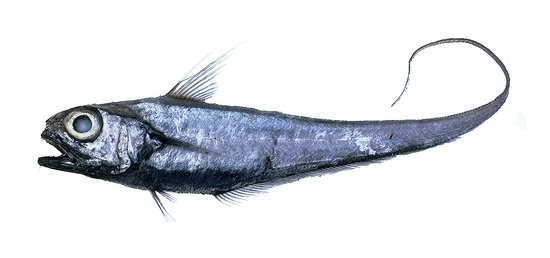- Classification
- ACTINOPTERYGII
- GADIFORMES
- MACROURIDAE
- Lepidorhynchus
- denticulatus
Toothed Whiptail, Lepidorhynchus denticulatus (Richardson 1846)

Lepidorhynchus-denticulatus. Source: Lepidorhynchus-denticulatus. License:
A silvery grenadier with a large almost terminal mouth, large teeth in the upper jaw, a smooth dorsal-fin spine, a dark non-silvery back, silvery sides, a dark-silvery lower surface and dusky fins. Mouth large, almost terminal. Small barbel.
This is the most common grenadier found in southeastern Australia, occurring at shallower depths than other macrourid species. Juveniles are usually in shallower waters than adults.
Toothed Whiptail, Lepidorhynchus denticulatus (Richardson 1846)
More Info
|
Distribution |
Confined to temperate waters of southern and southeastern Australia and New Zealand, although a single individual was recorded from the stomach of a squid caught off Oahu, Hawaii; benthopelagic on the continental shelf and slope at depths between 100-1000 m, although recorded as shallow as 60 m. |
|
Features |
D II, 10-12; P 15-18; V 9; GR 10-14; BR 6; PC 15-25. Head narrow, fairly deep, ridges poorly developed, low, lacking heavily modified scales; snout barely protruding, eyes large, suborbital region shallow, lacking a spiny ridge; mouth large, essentially terminal, chin barbel short, fine; upper jaw teeth small, conical, in broad band, outer row enlarged and widely-spaced canines; lower jaw teeth slightly enlarged, in single row. Body scales with short, needle-like spinules in more or less parallel rows. Elongate spine fo fisst dorsal fin smooth in adults; pelvic fin well developed, distal tip of outermost ray filamentous and hairlike, just reaching anal fin origin. Anus at anal fin origin; light organ with a distinctive prominent round, lens-like structure before anus; ventral surface of head and body with an extensive network of fine parallel blackish lines or striae assocatied with light producing system. |
|
Size |
Reaches a total length of 55 cm. |
|
Colour |
Silvery overall, dorsal parts of head and body greyish-green; ventral surface on abdomen and gills blackish; fins generally clear to pale dusky, pelvic fins blackish. |
|
Feeding |
Primarily carnivorous on benthopelagic fishes, cephalopods and a wide range of invertebrates including crustaceans, echinoderms, gastropod molluscs and polychaete worms; gut contents also reported to contain mesopelagic prey items. |
|
Fisheries |
Although not targeted, Lepidorhynchus denticulatus is abundant and frequently caught as bycatch in commercial fisheries off Tasmania and Victoria; important as a food source for commercial species such as Blue Grenadier, and used as tuna longline bait. |
|
Similar Species |
Other grenadiers lack silvery sides, the dark underside and large teeth in the jaws. |
|
Species Citation |
Macrurus, vel Lepidorhynchus denticulatus Richardson, in Richardons & Gray, 1846, Zool. Voy. H.M.S. Erebus Terror 2: 53, pl. 32 (fig. 1-3), coast of South Australia. |
|
Author |
Dianne J Bray |
Toothed Whiptail, Lepidorhynchus denticulatus (Richardson 1846)
References
Iwamoto, T. & P. J. McMillan. 2008. Macrouridae, In Gomon, M.F.,D.J. Bray & R.H. Kuiter. Fishes of Australia’s Southern Coast. New Holland Publishers & Museum Victoria, Melbourne, Australia. 1-928p.
Iwamoto, T. & Williams, A. 1999. Grenadiers (Pisces, Gadiformes) from the continental slope of western and northwestern Australia. Proc. Calif. Acad. Sci. 51(3): 105-243, figs. 1-58.
McMillan, P.J., Francis, M.P., James, G.D., Paul, L.J., Marriott, P.J., Mackay, E., Wood, B.A., Griggs, L.H., Sui, H. & Wei, F. 2011. New Zealand fishes. Volume 1: A field guide to common species caught by bottom and midwater fishing. New Zealand Aquatic Environment and Biodiversity Report No. 68, 329 pp.

